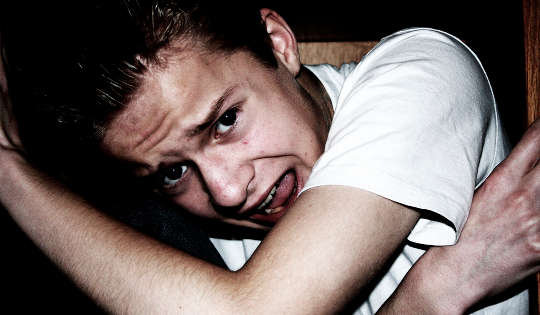 Laura Lewis, Claustrophobia IV. (CC BY 2.0)
Laura Lewis, Claustrophobia IV. (CC BY 2.0)
Most of us have something we say we’re afraid of, whether it be spiders, needles, or something more unusual like zombies. But when push comes to shove, we get rid of eight-legged beasts, will have that injection, or manage to sit through an episode of The Walking Dead – albeit behind the safety of a sofa cushion.
Fear and worry are intrinsic to being human, and it is common in early childhood to develop some fears that can be troubling and upsetting. Many little ones will cry at night, saying they are afraid of the dark, or of the monster under their bed, but as adults we can just brush these thoughts off. Though there is usually no harm waiting to befall us, evolutionary theorists think that children are biologically predisposed to learn certain fears to protect themselves from danger. This explains some of the most common phobias, such as fear of insects, snakes and heights.
Fear directed at objects, events or situations – “phobias” – in childhood are perfectly normal. They come and go, rarely requiring special attention or intervention. The list of phobias appears to be limitless, quite literally ranging from A to Z: from anatidaephobia, the fear that a duck is watching you, to zelophobia, a fear of jealousy.
Phobias only become clinically relevant if they occur at an inappropriate age – usually considered to be past 13 years old – and persist for six months or more, impacting significantly upon a person’s daily functioning. If this is the case they are referred to as “specific phobias”. Many specific phobias can be traced back to early triggering events, usually a traumatic experience at an early age. In childhood, the individual is unable to recognise that the fear is irrational. Even though evidence presented to them may show that there is no threat or danger, reasoning is rarely effective.
In adulthood, the individual is more likely to recognise that their fear is irrational and unreasonable, yet the physical manifestations of the phobia – trembling, shortness of breath, sweating and rapid heartbeat – are by no means less extreme or distressing. But this is not always the case. Adults can be swayed into believing an irrational phobia – and can even have their phobias set off by a similar fear in another person.
Catching contagions
Between the 14th and 17th centuries, a “plague” spread across Europe, forcing victims to dance uncontrollably, as well as exhibit other strange behaviours. Physicians at the time blamed the illness on “hot blood”. Psychologists have since surmised that the actions were possibly down to group hysteria or a stress-induced psychosis. Those who managed to survive the plague were thought to be so traumatised and vulnerable that this hysteria could easily have perpetuated the spread of the dancing disease, and made it as real as any infectious disease.
But our psychological understanding has advanced since then, so surely fears would not spread in a similar way any more?
In 2016, one mass phobia was linked to the “creepy clown” epidemic that swept across the US and UK. Though typically associated with children’s parties and fast food venues, psychologists have proposed that it could be clowns’ “suspiciously otherworldly qualities”, oversized extremities, and garish makeup and clothing that can be read as monstrous rather than playful and happy. In addition, many of the “mischievous” behaviours performed by clowns are seen to be antisocial rather than prosocial, creating feelings of unease in young children, adolescents and adults alike.
Many were heard claiming they had a “phobia” of clowns, after hearing news of how a small few were waiting on street corners seemingly ready to attack. This is an example of “contagion”, a social psychological metaphor which refers to the spread of a behaviour pattern, attitude or emotion from person to person, or group to group – like the dancing plague. It moves through suggestion, propaganda, rumour, or imitation. Indeed, informational transmission or contagion is one of several possible explanations for acquiring a sudden fear of an object or situation, when others have it too.
In the case of the creepy clowns, overhearing conversations, reading stories on social media or indeed seeing an individual dressed up as a clown could have contributed to the development of the phobia.
We have great power and influence over each other: sometimes we are aware of this, other times not. Ultimately, we cannot simply say that phobias are contagious – you certainly can’t catch them like you might do a cold. But your phobia could induce another to act in a certain way, or make them believe they too have your fear.
![]()
About The Author
Clare Glennan, Lecturer of Psychology, Cardiff Metropolitan University
This article was originally published on The Conversation. Read the original article.
Related Books
at InnerSelf Market and Amazon























